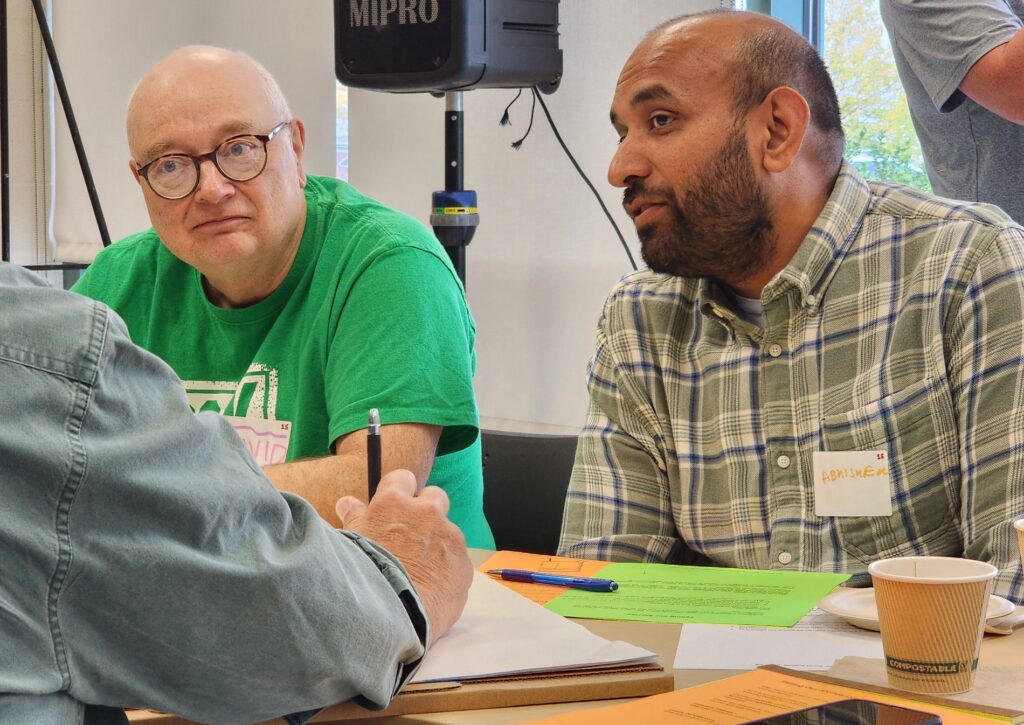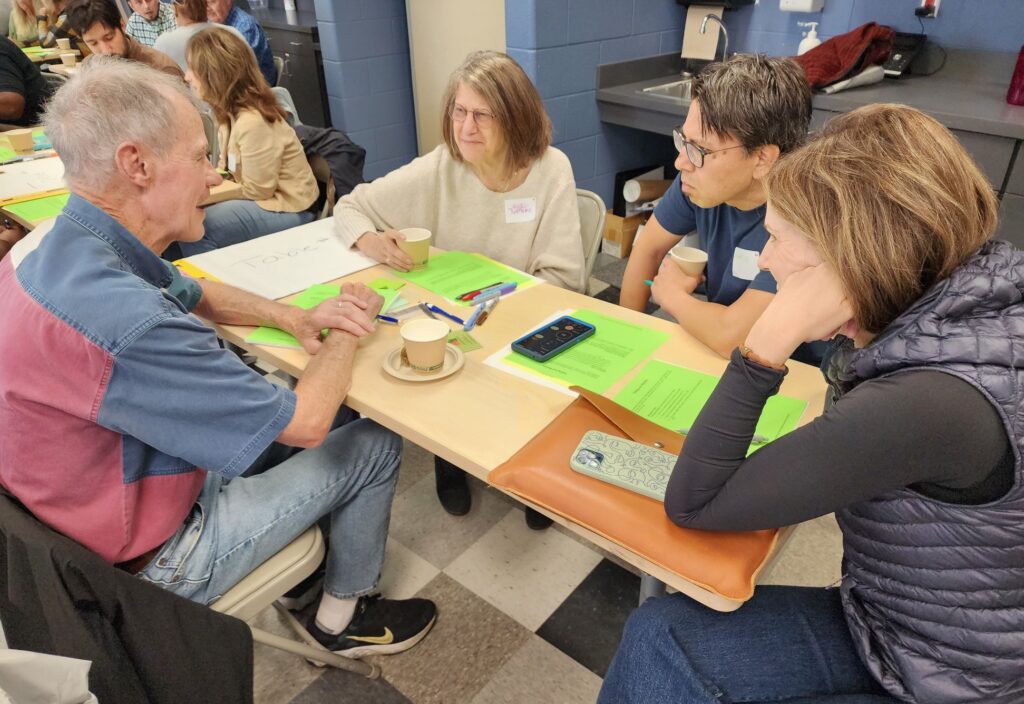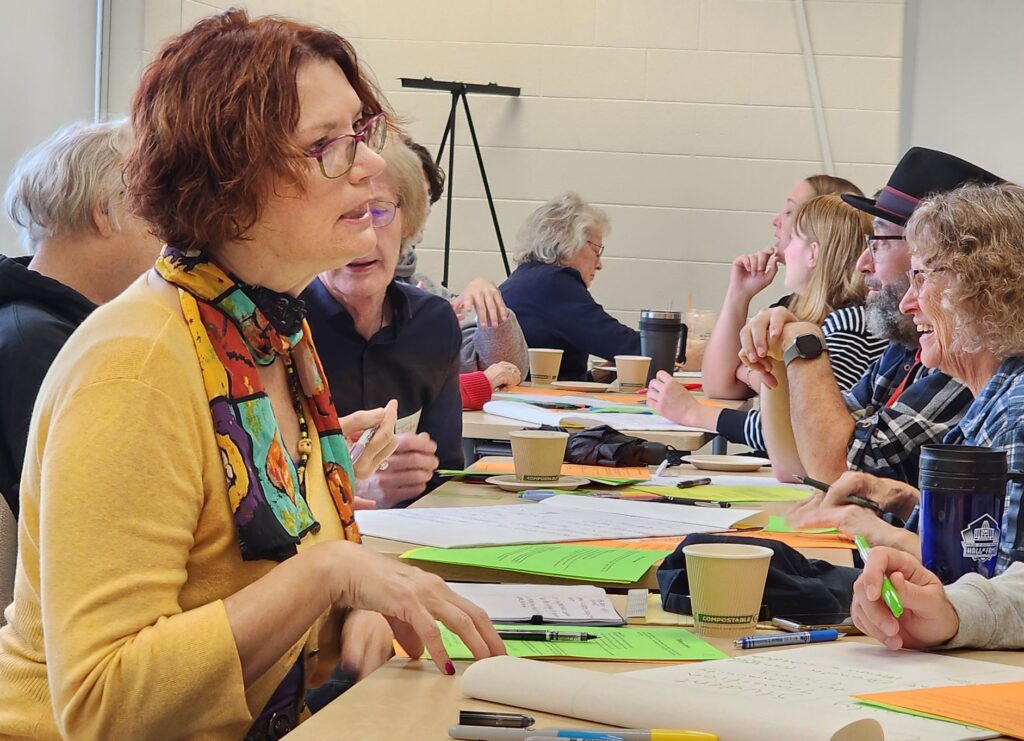By JAN McLAUGHLIN
BG Independent News
Nearly 75 Bowling Green residents spent five hours, used countless sticky notes, and emptied multiple coffee dispensers Saturday as they tackled the issues of housing and mobility in the city.
The “Call to Action” gathering was put together by the BG Save Our Neighborhoods Group, a non-profit organization trying to increase housing options in the city. The entire community was invited to be part of the discussion, and the faces around the tables ranged from BGSU students and parents with young children, to business owners and city officials, to senior citizens and long-time townies.

While the discussions resulted in hundreds of ideas condensed on sticky notes, the goal from Saturday’s meeting was to narrow the priorities down to a handful that could be accomplished in six months to a year.
When the voting was done, Rose Drain, the president of BG SONG, announced the initial action items to be worked on with the city and community partners.
“The people have spoken,” Drain said, as she read off the top goals:
- Revitalize properties in the city, through enforcement of the exterior housing code, and expansion of the volunteer “Rock the Block” program that helps homeowners fix up their properties.
- Conduct a public transit feasibility study.
- Prepare for climate change by creating a sustainability task force.
- Study new housing options in the older neighborhoods surrounding the central downtown area.

To get to those goals, the Saturday session – organized by members of the BGSU master of organization development program – began with participants being asked to list sources of pride and frustration in Bowling Green. Making the proud list were the parks, green power, diversity, BGSU, downtown, vibrant senior community, small town feel, historic preservation, small businesses, walkability and being a safe city.
On the frustration list were lack of public transportation and bike-pedestrian infrastructure, school funding and facilities, bad sidewalks, lack of affordable and quality housing, single-family homes being turned into rentals, lack of retail, slow pace of change, lack of enforcement of rental properties, and a divide between city and university.
Participants were also asked how they would change Bowling Green, if given a magic wand. The ideas included better enforcement of self-inspections by landlords, equitable density of housing, road diet making room for more bicycle and pedestrian options, higher quality housing, stormwater management and more public transportation. The wishes also asked for more restaurants, less deer, and more respect for women business owners.

A panel discussion presented the expertise and perspectives of Ben Burghart, a BGSU architecture professor; Maddi Meinich, of the BGSU Center for Regional Development; Kathy Newlove, of Newlove Realty; and Dave Steiner, director of the Wood County Planning Commission.
Burghart shared a story about a type of housing not available in Bowling Green. It involved a complex that was in some ways a community unto itself. There would be a variety of size and accessibility living options, child care, a grocery store under the residential areas, a garden for those living there, a shared workshop, and a community car share program.
Meinich talked about the housing problems facing BG that are also being experienced around the nation. The barriers to neighborhood revitalization are often costs and consensus.
Meinich reported on the numbers that show Bowling Green residents as having a heavy housing cost burden:
- Ideally a homeowner or renter should not spend more than 30% of their income on housing. In Ohio, 25% of residents spend above the 30% – while in Bowling Green the number is 39%. Also in Ohio, 11% of residents pay above 50% of their income for housing – while in BG the number is 22%.
- 66% of housing in Bowling Green is renter occupied, while 34% if owner occupied.
- BGSU enrollment went up 22% in the last two years.
- BG has a 0% homeowner vacancy rate.
- 73% of people buying and moving into homes in BG already live in the city.
Bowling Green could benefit from different kinds of housing options, like townhouses and collaborative housing, Meinich said.
While the increased enrollment is good news for BGSU, those students will need to be absorbed into housing in the community. When the Abbott Lab opens on the north edge of BG, will there be housing options for them here, Meinech wondered.
“We want this to be their home,” she said.

Newlove said the barriers to housing revitalization in BG include manpower and money. She praised the “Rock the Block” program which helps homeowners address issues primarily to the exterior of homes.
Newlove suggested that each year the city points out the 10 worst maintained residential properties in BG. If the city set up a $100,000 fund, $10,000 grants could be given to each of the homeowners, and a lien could be put on the properties. If the residents improve the property and continue living there for at least seven years, they would not have to pay back the grant, she suggested.
The city needs more owner-occupied homes east of Enterprise Street, low-income condos for baby boomers, and more homes in the price range of $100,000 to $200,000, she said.
The community also needs to stop viewing landlords as the enemy, said Newlove, who stressed that she sells homes, not rents them out.
“Landlords are not really looked upon well in town,” she said. “But we can’t live without landlords. We need to work with landlords instead of pointing out how bad they are.”
Steiner talked about the countywide lack of housing – especially affordable housing.
The northern part of Wood County is booming with new industry, but housing options are lagging far behind.
“We don’t have housing for those workers,” he said.
Meanwhile, plans for rental housing often face strong pushback from neighbors looking at such housing from a NIMBY perspective.
“They don’t want it in their backyard,” Steiner said.

Rose Drain painted a positive picture of Bowling Green’s future.
“It’s so gratifying that we have so many people in the community who want to come together to solve problems,” she said.
“How can we make sure BG remains a vibrant community for everyone,” she said, listing off the threads that create the fabric of Bowling Green. The history, culture, green space, businesses, schools and BGSU are all parts to be proud of, Drain said.
“They’re worth fighting for. It’s up to us – students, families, business owners,” she said. “BG has a strong heart, but it’s up to us to keep that heart beating.”
“This just isn’t about bricks and mortar, or bike lanes,” it’s about making all people feel they belong here, she said.
As the meeting concluded, BG SONG member David Drain encouraged those attending to be part of the “Call to Action” movement in Bowling Green.
“Let’s keep this momentum going beyond today,” he said.


